

by John Helmer, Moscow
@bears_with
There is only one certainty (zweifelsfreie Nachweis) in the case of Alexei Navalny and the traces (Spuren) which have been found in his skin, urine and blood, and in a water bottle, by the German Army’s chemical warfare laboratory in Munich.
This certainty is that, in order to believe the German and other government interpretations which have been given of the evidence to date, you have to be suffering from a severe case of brain washing. The lighter the spectrometric mass or weight of the reported Novichok spuren, the heavier the measurable wash on the brain required to believe they are evidence of a Russian state crime.
In political weight, however, Navalny in his present condition is now more valuable outside Russia than he was, or ever could have been, inside Russia when he was in full health. In the politics of next year’s German election, when Chancellor Angela Merkel will not be running, the Navalny case weighs more heavily than the Litvinenko, Magnitsky, MH17, and Skripal cases all rolled into one.
In the official exchanges to date, the Russian and German governments have demanded transparency from the other. The German Chancellery declared on September 2 that the “Russian government is asked urgently to explain itself”. The Russian Government had already provided, not only Navalny himself, his clothes, and his medical condition reports to the Charité Clinic in Berlin, but it had sent a formal request from the Prosecutor-General in Moscow for German reciprocity – for medical condition evidence, and such evidence as the counterpart German authorities had obtained of a criminal attack.
In response, the Germans have produced not a single medical datum, pathology, toxicology or forensic report. Not one.
Chancellor Angela Merkel, graduate of the Central Institute of Physical Chemistry in Berlin with a PhD in quantum chemistry, knows what a datum is, and what it isn’t. “Spuren are not facts”, an internationally known German banker with links to the chancellery observes: “For a scientist, Merkel knows what these things mean. In this case, everything she knows she has thrown away.”
According to the Berlin clinic statement of August 24: there had been “poisoning with a substance from the group of cholinesterase inhibitors”. This claim was signed by a press agent, not a doctor or the head of the patient treatment team.
German hospital protocol and the requirements of patient privacy require the treating doctor to take responsibility for release of information, and the patient or his family to agree to the doctor’s disclosures. The clinic acknowledged the second, but ignored the first: “After close consultation with the patient’s wife, Charité is reassured that the decision to make details of the patient’s condition public would be in accordance with his wishes.” Manuela Zingl, the press agent who signed her name to this, was asked by Florian Roetzer of Telepolis, to name the head of Navalny’s treatment team and to provide details of the treatment. She refused.
Zingl’s reply was: “we would like you to refer to our press release from August 24th, 2020.” This is a point-blank refusal of transparency. It is “disappointing”, commented an influential German source, “that the Germans didn’t follow normal procedure.”
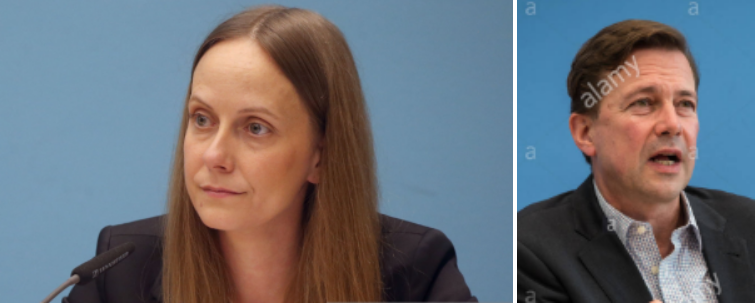
Left, Manuela Zingl, press agent for Charité Clinic in Berlin. Right, Steffen Seibert, head of the German Government’s Press and Information Office.
On September 2 Steffen Seibert issued a statement in Berlin claiming to be what the Institut für Pharmakologie und Toxikologie der Bundeswehr (IPTB) in Munich had reported to Merkel and a meeting of her ministers. The statement claimed that “at the instigation of the Charité medical university Berlin a special laboratory of the armed forces carried out a toxicological investigation [toxikologische Untersuchung] on the basis of Alexei Navalny’s tests [proben]. On this occasion, the definite proof [zweifelsfreie Nachweis] of a chemical nerve agent of the Novitchok group was produced.”
No understanding of German is needed to register what Seibert and his government did not reveal. There was no toxicology report from IPTB; no name of the IPTB expert in charge of the testing and of the interpretation of the results; no name of the chemical compound of the “Novichok group”, which IPTB will either have explicitly reported on paper, according to the naming protocol of the International Union of Pure and Applied Chemistry (IUPAC); or else the report fails to do that because its toxikologische Untersuchung was inconclusive.
The name of the IPTB head is Army Colonel Professor Doctor Horst Thiermann. His name should have been signed in the IPTB report which went to Chancellor Merkel for her meeting with the foreign, defence, and finance ministers on September 2. Thiermann is one of the NATO officers who says in public there were nerve agent poisoning attacks by the Assad government in Syria. Thiermann is not a trained forensic toxicologist, according to a leading British specialist on the organo-phosophate compounds and nerve agents.

Left: the IPTB headquarters in Munich. Right, Colonel Professor Doctor Thiermann, as he appeared to speak at a public forum on Syrian chemical warfare attacks sponsored by the US military contractors, General Dynamics and Lockheed Martin. Thiermann’s record reveals traces (spuren) that he has been taking benefits from US military sources, though not definitive proof (zweifelsfreie Nachweis) that the sources have contaminated his judgement.
The day after Seibert’s claim was issued, Der Spiegel reported what had happened when Merkel called in her ministers for a kaffeeklatsch. “Officially it was an invitation for coffee drinking [Kaffeetrinken] when Angela Merkel gathered on the Wednesday afternoon her six most important ministers in the chancellor’s office; convening the security cabinet would have caused too much sensation… The results of analysis of the Munich armed forces institute of pharmacology and toxicology were given by a senior staff doctor who had already examined poison attacks in Syria, [Merkel] explained to the members of the cabinet. The result was a political bomb [politische Bombe].”
The difference in German between kaffeeklatsch (“coffee gossip”) and kaffeetrinken (“coffee drinking”) isn’t the coffee. It’s the truthfulness of what was said. Der Spiegel doesn’t name the “senior staff doctor” nor whether he briefed the chancellor in person; by Zoom; or on paper. Der Spiegel doesn’t know, and wasn’t told, what was in Col Thiermann’s report. The one fact Der Spiegel got right was politische Bombe – that’s to say, propaganda.
The record of the Navalny case assembled in Moscow, Tomsk, and Omsk — and in the air between – has been qualitatively different from the German record, or the record Navalny’s wife, Yulia Navalnaya, and their staff have been making in the western press. Their record reached a climax with the production in Germany, though not in Russia, of a water bottle. That too is a politische Bombe.
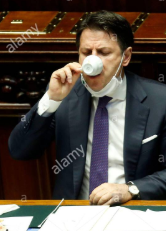
On August 26, in a telephone conversation between President Vladimir Putin and the Italian prime minister Giuseppe Conte (right), Conte initiated a mention of the Navalny case.
According to the Kremlin communiqué, “Vladimir Putin and Giuseppe Conte also spoke about the situation with Alexei Navalny’s stay in hospital. The Russian President stressed the inadmissibility of premature and unsubstantiated accusations in this connection and expressed interest in a thorough and impartial investigation of all the circumstances of the incident.”
Responding to the Berlin clinic claim, Foreign Minister Sergei Lavrov said in a speech to Moscow university students on September 1: “I have listed just a few [claims] that have been created by the British side without any proof. They are urging the doctors in Omsk to immediately present their reports so that we can investigate why Mr Navalny went into a coma. Do you remember that he was taken to hospital in Omsk for slightly more than twenty-four hours? All our Western colleagues were making a fuss, wondering why there was no information. Well, he is at last in Germany and has been there for a week and the German doctors are providing no information either. This means some additional time is needed, doesn’t it? But for some reason, no one is urging them or denouncing them for ‘attempting to withhold the truth.’”
“They are accusing us of doing nothing to investigate this affair. This is not true. The Interior Ministry launched a pre-investigation probe on the actual day, when it all occurred. An investigation can only begin when it is established what really happened. And this, let me repeat it, is not yet clear. The German doctors are still unable to report to us the relevant information. The Russian Prosecutor General’s Office asked their colleagues in Germany to activate the Agreement on Mutual Legal Assistance.”
At that point it wasn’t as clear as it has become that the German prosecutors are refusing to hand over the Berlin clinic case evidence or the Munich laboratory evidence. On September 4, two days after Merkel issued her press release, Lavrov was more explicit: “Let me recall again that as soon as Navalny felt unwell on the plane it landed immediately. An ambulance was waiting for him in the airport and he was instantly taken to hospital, switched to an artificial lung ventilator and given other necessary measures. As I understand it, Navalny spent a bit more than a day and a half there. During this time, we were urged every hour to explain what happened and report any information immediately.”
“For over a week after he was taken to Germany, no one who raised a concern during his stay in Omsk has expressed interest in his case or loudly demanded information from the German doctors. We don’t have new information on this up to this day. It’s the same old story: we are publicly accused of something and our official requests for answers to specific questions from the Russian Prosecutor-General’s Office, under legal assistance treaties, remain unanswered. German Federal Chancellor Angela Merkel has been accusing us for two days of this action (ostensibly, the poisoning) but cannot present anything specific. Today, we once again asked our colleagues in the EU and Germany whether Ms Merkel plans to instruct her staff to send the German Justice Ministry’s response to the Russian Prosecutor General’s Office inquiry.”
“I already have to say out loud that we have information that this reply is being delayed due to the position of the German Foreign Ministry. We have instructed the Russian Ambassador to Germany to ask for a reason for the delay. Today we were at least promised that the reply would come soon. We will react when we receive it with specific facts. As I see it, the Germans believe their reply will contain these facts. Let me repeat that, regrettably, all this brings to mind what happened with the Skripals and other incidents where Russia was groundlessly accused and the results of the investigation (that took place in Britain in the latter case) remain classified. Nobody sees the Skripals themselves.”
Compared to the record which the British government, Salisbury Hospital, the chemical warfare laboratory at Porton Down, and the Metropolitan Police provided in the Skripal case, the Russian record has been much faster in the open-access media; more comprehensive in covering witnesses and locations; more thoroughly documented with CCTV, film and photographs; and without contradictions.
Two media sources with a long history of hostility towards President Putin have provided these records; the first and most thorough is the BBC Russian Service timeline, published on September 2.
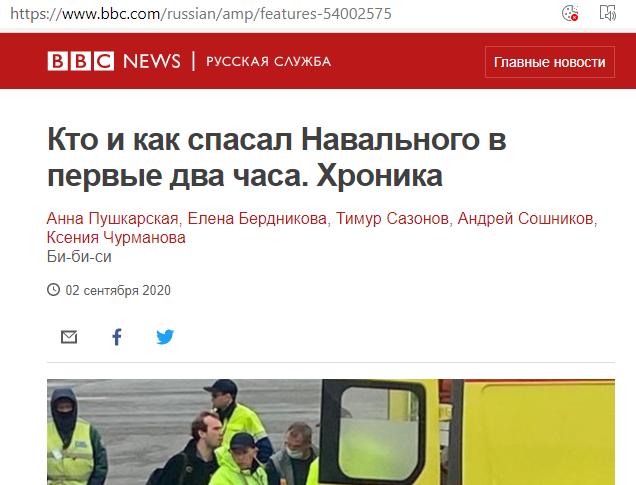
Source: https://www.bbc.com/russian/ In English: https://www.bbc.com/news/
If the BBC has reported accurately, there was little room in terms of time, opportunity, or unfilmed contact to show how an attacker might have struck Navalny through the cup of tea bought for him by an assistant at a Tomsk airport café and taken to his table. The assistant, Ilya Pakhomov, can be viewed buying, then delivering the cup of tea to Navalny, in this CCTV footage recorded approximately 60 minutes before the flight departed. It is evident from the film that the café serving personnel could not have known for whom the cup of tea was intended; only Pakhomov knew that. He and Yarmysh were then seated next to Navalny on board the flight to Moscow.
Also, the number of people assisting Navalny in the plane and then upon landing at Omsk airport, and the uniform absence of their contamination afterwards, not only reveal a record of quite different symptoms displayed by Navalny, compared to those which witnesses reported of Yulia and Sergei Skripal; their record also suggests something quite different biomedically, and also forensically, from the Salisbury episode.
Meduza, the Russian opposition website based in Latvia, has also published a detailed review of the testing on Navalny before he left for Germany. This includes snapshots of Omsk Emergency Hospital No. 1 reports identifying some of the tests which were carried out. Meduza also reports that the IPTB laboratory in Munich had samples of Novichok before the Navalny samples arrived for mass spectrometric matching: “A sample of the poisonous substance in question is typically needed for additional confirmation — mixing it with a sample of uncontaminated blood allows for comparing the mass spectrometry results. It looks like this is how the German chemists confirmed that Navalny was poisoned with a substance from the Novichok group.”
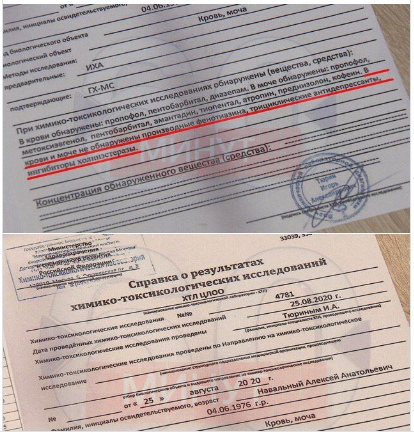
Extracts of Omsk Emergency Hospital No. 1 Hospital testing reports for Navalny, published by Meduza: The top document, reporting mass spectrometry testing, shows the official stamp and signature of the responsible doctor, Igor Turin. He reports finding in Navalny’s bloodstream and urine: propofol, pentobarbital, diazepam. “Found in urine: propofol, methoxyeugenol, pentobarbital, amantadine, thiopental, atropine, prednisolone, caffeine. Phenothiazine derivatives, tricyclic antidepressants, cholinesterase inhibitors were not detected in blood and urine.” The bottom document is also signed by Turin. It is a chemical-toxicological report on Navalny’s blood and urine dated August 25, five days after Navalny’s admission to the hospital. A British specialist comments: “propofol and diazepam with atropine would be classic drug treatments. The first two calm the patient down. Atropine is an antidote which we know well. The other drugs relate to psychotic conditions. In the UK it would be a breach of patient confidentiality to publish this list of very powerful medications. That was quite a mixture.” Alexander Sabaev, chief toxicologist at the Omsk hospital, gave this retrospective account of what drugs had been administered by the treating staff, and why, after Navalny’s admission.
What is missing from the BBC and Meduza records, compiled after Navalny had reached Berlin, and the Russian reporting while he was still in flight between Tomsk and Omsk, and then in Omsk Emergency Hospital No. 1, is the water bottle which was reportedly analysed by the IPTB in Munich.
There is only one press source, Der Spiegel, for the claim this bottle was taken by Navalnaya from Russia to Germany, when she accompanied Navalny on the charter flight to Berlin, and then handed the bottle over for testing there. She did not report it, nor was it tested in Omsk. No witness identified in Tomsk airport or on board the aircraft, S7 Flight 2614, has mentioned seeing Navalny drinking from the bottle. None of the in-flight aircraft crew nor the medical staff who treated Navalny before he was taken by ambulance from the airport, recorded seeing the bottle. “He didn’t eat or drink anything all morning”, the BBC reported, “apart from a cup of tea he bought at Tomsk Bogashevo airport, according to his press secretary Kira Yarmysh”. Yarmysh was sitting next to Navalny in the aircraft.
The Navalnaya bottle has now been reported by IPTB to be showing “traces” of the alleged poison. It appears to be the German equivalent of Sergei Skripal’s front-door handle, and Dawn Sturgess’s perfume atomiser. For the full story on what they were (and were not), read the book.
SMOKING-GUN EVIDENCE – THE NAVALNAYA BOTTLE, SKRIPAL DOOR-HANDLE; STURGESS PERFUME ATOMISER
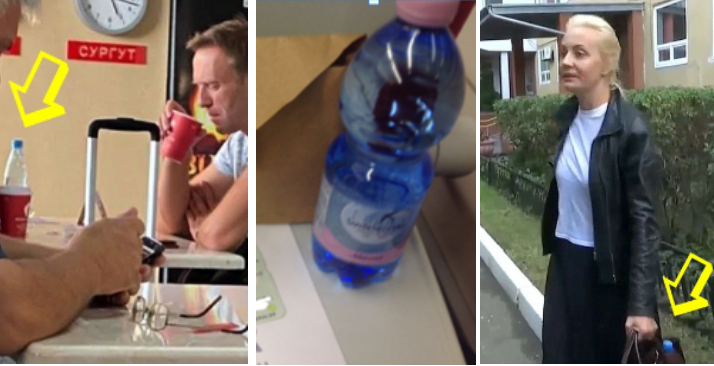
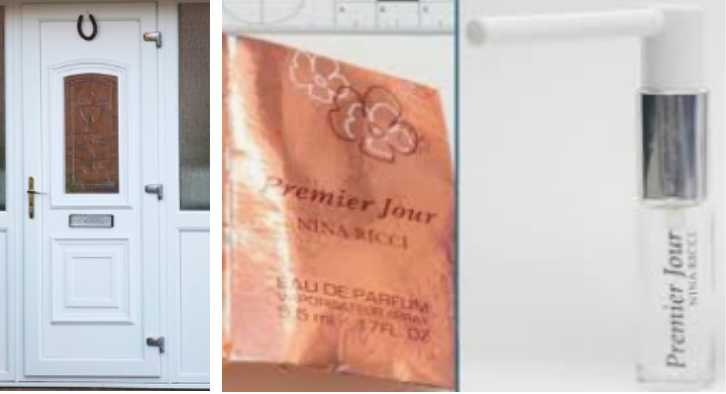
Top: left, a partially consumed bottle of water, with blue cap, in front of Alexei Navalny, as he drank tea at a Tomsk airport café before boarding his S7 flight to Moscow; centre, a bottle of water for purchase on S7 flights, with pink cap; right, Yulia Navalnaya speaking to reporters outside Omsk Emergency Hospital No. 1, with a blue-topped bottle in her handbag. Bottom: left, the front-door handle at Sergei Skripal’s home in Salisbury; right, perfume package and dispenser used by Dawn Sturgess.
Yulia Navalnaya has not been asked by, nor explained to German or other reporters how she came by the bottle, why she did not provide it for testing in Omsk, and how she protected herself and her handbag from contamination by the “traces” later discovered on or in the bottle. Navalnaya is also refusing to reveal, or allow Navalny’s doctors to report on several of his prior illnesses and medical preconditions; these are known to reflect sudden reduction in blood sugar and cholinesterase levels – diabetes, Quincke’s Disease, and allergies leading to anaphylactic shock.
The British organo-phosphate expert adds: “I can’t stress enough the need for the German scientists to be specific. To speak of ‘Novichok family’ or ‘Novichok class or group’ is just not good enough. This is no reason why the correct IUPAC chemical name should not be stipulated. Without this certainty, there is no analysis that can stand up as toxicologically defensible evidence of a crime.”
On Sunday morning, September 6, Maria Zakharova, the Foreign Ministry spokesman, declared: “So far, there is no certainty that a double game is not being played in Germany, because the Berlin Justice Department, which is responsible for considering issues of providing legal assistance, received the Russian Prosecutor General’s Office’s request from German authorities. Where is this ‘urgency’ that you insist on? … By not sending a response, Berlin is slowing down the investigation it is calling for. Is it being done on purpose?”
“We are ready to interact with the German side 24 hours a day. I would like to remind you that when Russian ambassador [Sergei Nechaev] was at the German Foreign Ministry, he asked if there was any specific data that the Russian side could get familiar with to advance the investigation [into the Navalny case], but nothing was transferred to him. The situation remains the same today.”
Nechaev had been to the Foreign Ministry in Berlin on September 2. Zakharova reported the result that day. “What answer do you think he received from the German counterparts? None. No facts, no data, no formulas, no materials, no references. Absolutely nothing.”
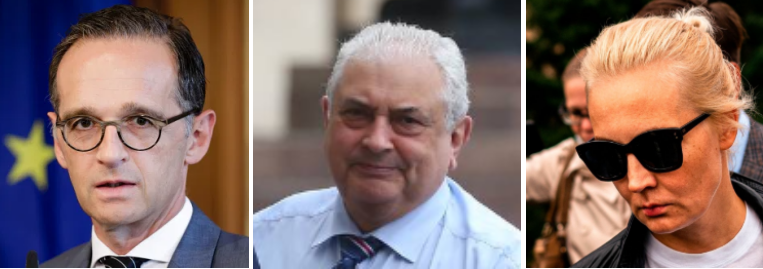
Left to right: German Foreign Minister Heiko Maas; Russian Ambassador to Germany Sergei Nechaev; Yulia Navalnaya at Omsk Emergency Hospital No. 1 on August 21.
Replying to Zakharova on Sunday evening, Heiko Maas, the German Foreign Minister, implied the initial German medical reports did not disclose evidence of a crime, and that Navalnaya is blocking release of the data to the Russian prosecution. “We agreed on this request for legal assistance sent by Russia. This means that the information that is being requested can be issued by our side, but this is a process since new data is constantly being received — Navalny is being further treated, it is being checked how much poison remains in his body or it is already being excreted. It is still necessary to clarify this [request] with the medical workers at Charité, with those who examined the samples. In the research results, there is personal data, the permission [to transfer] of which must be granted by those to whom they belong. Therefore, there are numerous levels, but regarding what concerns us, we have given all the agreements on what is necessary in order to implement this process.”






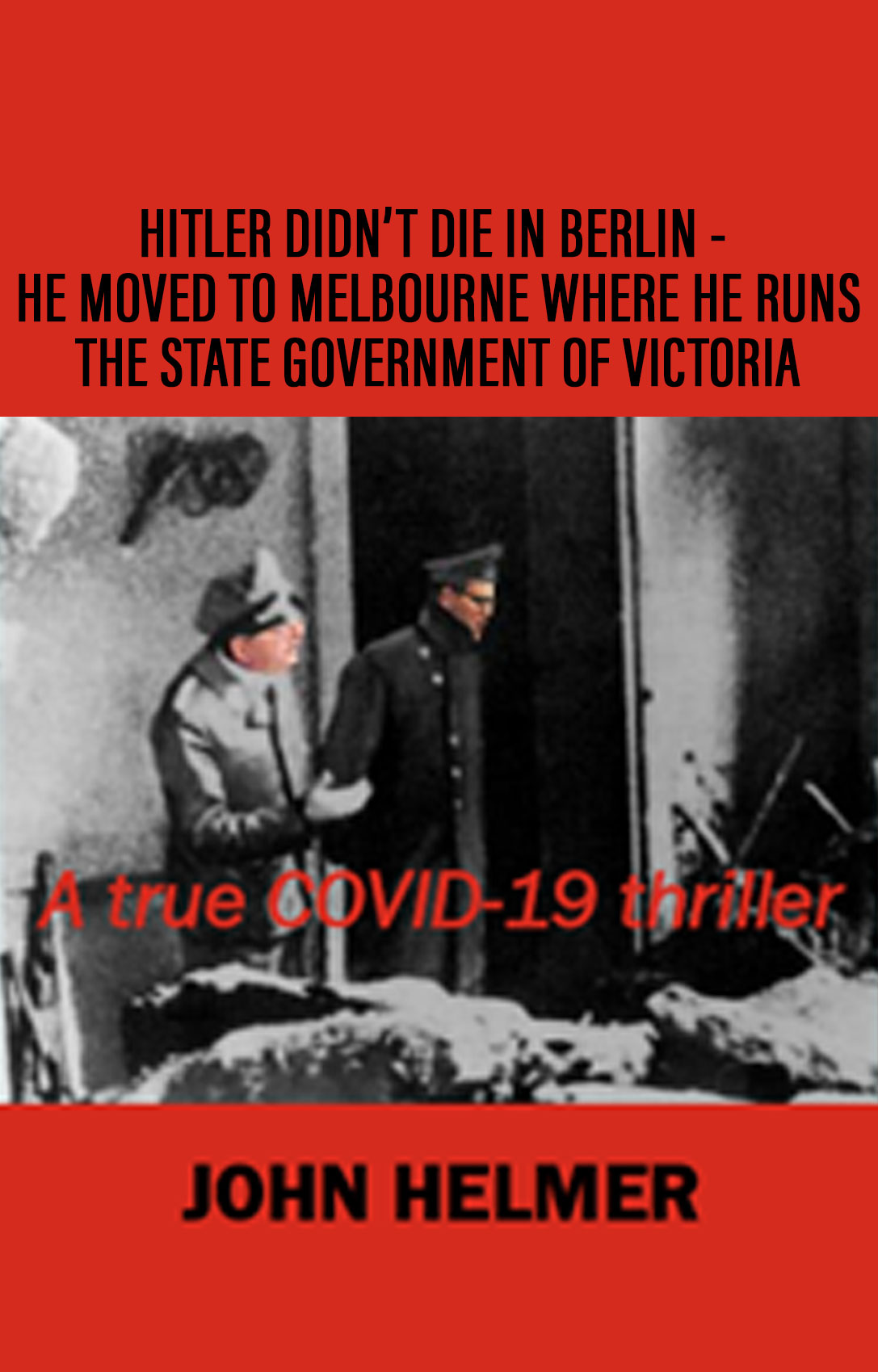




Leave a Reply